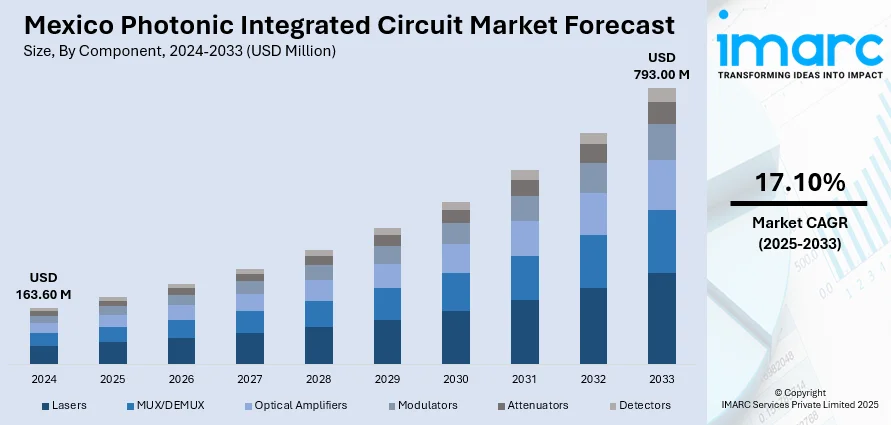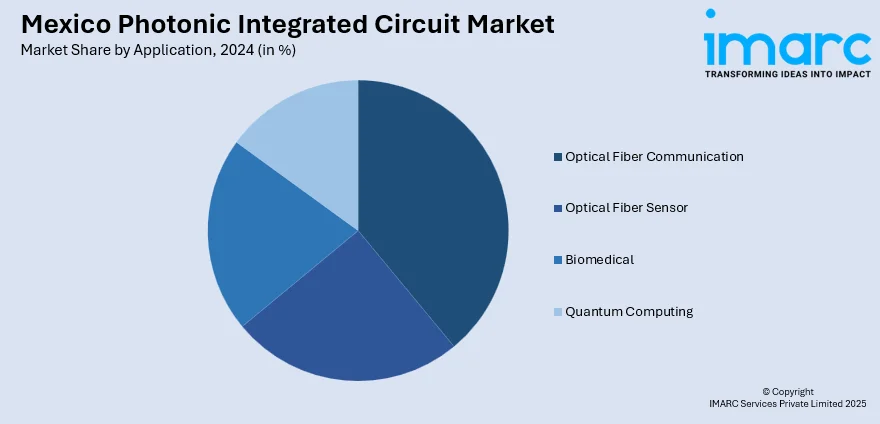
Mexico Photonic Integrated Circuit Market Size, Share, Trends and Forecast by Component, Raw Material, Integration, Application, and Region, 2025-2033
Mexico Photonic Integrated Circuit Market Overview:
The Mexico photonic integrated circuit market size reached USD 163.60 Million in 2024. Looking forward, IMARC Group expects the market to reach USD 793.00 Million by 2033, exhibiting a growth rate (CAGR) of 17.10% during 2025-2033. The increasing demand for high-speed internet, rising adoption of advanced communication technologies, and government-led digital transformation initiatives are among the key factors propelling the market growth. Besides this, the expanding data center infrastructures and the expanding electronics manufacturing sector are also supporting PIC integration across telecom, defense, and healthcare applications.
|
Report Attribute
|
Key Statistics
|
|---|---|
|
Base Year
|
2024 |
|
Forecast Years
|
2025-2033
|
|
Historical Years
|
2019-2024
|
| Market Size in 2024 | USD 163.60 Million |
| Market Forecast in 2033 | USD 793.00 Million |
| Market Growth Rate 2025-2033 | 17.10% |
Mexico Photonic Integrated Circuit Market Trends:
Expansion of High-Speed Data Infrastructures
Mexico's rapid digital transformation is driving significant investments in telecommunications and data center infrastructure, increasing the deployment of photonic integrated circuits (PICs), which are required for high-speed, low-latency data transmission. Mexico has over 121 million active broadband customers, making it one of Latin America's major telecommunications markets, with revenue expected to exceed MXN 577 billion (nearly USD 34 billion) by the end of 2023. The country's 5G deployment is also gaining traction, with mobile connections projected to increase from 16.9 million in 2025 to 87 million by 2030. This shift demands advanced optical technologies, and PICs are increasingly essential due to their scalability, efficiency, and ability to handle growing data traffic. Simultaneously, Mexico’s data center landscape is expanding, featuring 170+ data centers and about 32 colocation providers, as of April 2025, reflecting a surge in data consumption across industries. PICs, with their ability to deliver higher bandwidth and lower latency, are crucial to meeting these infrastructure demands. Together, these advancements are positioning Mexico as a regional hub for photonics, supporting economic diversification, and driving technological innovation.

Integration of PICs in Healthcare and Smart City Applications
PICs are gaining traction in Mexico’s healthcare and smart city sectors, aligning closely with the country’s goals for technological progress and economic diversification. In healthcare, PICs are transforming medical diagnostics by enabling precise, real-time data analysis, which significantly improves patient outcomes. Researchers are also advancing silicon photonics-based biosensors that can detect multiple biomarkers simultaneously, enhancing early disease detection and diagnosis. On the urban development front, Mexico’s Smart Cities market is projected to reach USD 943.2 million in revenues by 2025, with an anticipated CAGR of 11.54% from 2025 to 2029, leading to a market volume of approximately USD 1.46 billion by 2029. PICs are central to this growth, underpinning smart infrastructure with high-performance communication systems and efficient data processing capabilities. Additionally, the rapid increase in IoT device deployment necessitates robust, high-speed connectivity, an area where PICs excel, ensuring seamless integration and real-time responsiveness. The widespread adoption of PICs is thus enhancing service delivery while driving Mexico’s innovation-driven digital transformation.
Mexico Photonic Integrated Circuit Market Segmentation:
IMARC Group provides an analysis of the key trends in each segment of the market, along with forecasts at the region/country level for 2025-2033. Our report has categorized the market based on component, raw material, integration, and application.
Component Insights:
- Lasers
- MUX/DEMUX
- Optical Amplifiers
- Modulators
- Attenuators
- Detectors
The report has provided a detailed breakup and analysis of the market based on the component. This includes lasers, MUX/DEMUX, optical amplifiers, modulators, attenuators, and detectors.
Raw Material Insights:
- Indium Phosphide (InP)
- Gallium Arsenide (GaAs)
- Lithium Niobate (LiNbO3)
- Silicon
- Silica-on-Silicon
A detailed breakup and analysis of the market based on the raw material have also been provided in the report. This includes indium phosphide (InP), gallium arsenide (GaAs), lithium niobate (LiNbO3), silicon, and silica-on-silicon.
Integration Insights:
- Monolithic Integration
- Hybrid Integration
- Module Integration
The report has provided a detailed breakup and analysis of the market based on the integration. This includes monolithic integration, hybrid integration, and module integration.
Application Insights:

- Optical Fiber Communication
- Optical Fiber Sensor
- Biomedical
- Quantum Computing
A detailed breakup and analysis of the market based on the application have also been provided in the report. This includes optical fiber communication, optical fiber sensor, biomedical, and quantum computing.
Regional Insights:
- Northern Mexico
- Central Mexico
- Southern Mexico
- Others
The report has also provided a comprehensive analysis of all the major regional markets, which include Northern Mexico, Central Mexico, Southern Mexico, and others.
Competitive Landscape:
The market research report has also provided a comprehensive analysis of the competitive landscape. Competitive analysis such as market structure, key player positioning, top winning strategies, competitive dashboard, and company evaluation quadrant has been covered in the report. Also, detailed profiles of all major companies have been provided.
Mexico Photonic Integrated Circuit Market News:
- February 2025: Mexico launched the Kutsari Project to strengthen its semiconductor sector through enhanced design, revised patent laws, and new R&D centers. This three-phase initiative includes a National Semiconductor Design Center and aims to reduce import reliance. The plan boosts local innovation and supports the development of technologies, including PICs.
- January 2025: Quantinuum announced plans to open a photonics research center in New Mexico to advance photonics technologies essential for quantum computing. The center will reportedly leverage local expertise from Sandia and Los Alamos National Laboratories. This initiative will support the development of PICs critical to product advancements, including quantum computing and communications technologies.
Mexico Photonic Integrated Circuit Market Report Coverage:
| Report Features | Details |
|---|---|
| Base Year of the Analysis | 2024 |
| Historical Period | 2019-2024 |
| Forecast Period | 2025-2033 |
| Units | Million USD |
| Scope of the Report | Exploration of Historical Trends and Market Outlook, Industry Catalysts and Challenges, Segment-Wise Historical and Future Market Assessment:
|
| Components Covered | Lasers, MUX/DEMUX, Optical Amplifiers, Modulators, Attenuators, Detectors |
| Raw Materials Covered | Indium Phosphide (InP), Gallium Arsenide (GaAs), Lithium Niobate (LiNbO3), Silicon, Silica-on-Silicon |
| Integrations Covered | Monolithic Integration, Hybrid Integration, Module Integration |
| Applications Covered | Optical Fiber Communication, Optical Fiber Sensor, Biomedical, Quantum Computing |
| Regions Covered | Northern Mexico, Central Mexico, Southern Mexico, Others |
| Customization Scope | 10% Free Customization |
| Post-Sale Analyst Support | 10-12 Weeks |
| Delivery Format | PDF and Excel through Email (We can also provide the editable version of the report in PPT/Word format on special request) |
Key Questions Answered in This Report:
- How has the Mexico photonic integrated circuit market performed so far and how will it perform in the coming years?
- What is the breakup of the Mexico photonic integrated circuit market on the basis of component?
- What is the breakup of the Mexico photonic integrated circuit market on the basis of raw material?
- What is the breakup of the Mexico photonic integrated circuit market on the basis of integration?
- What is the breakup of the Mexico photonic integrated circuit market on the basis of application?
- What are the various stages in the value chain of the Mexico photonic integrated circuit market?
- What are the key driving factors and challenges in the Mexico photonic integrated circuit market?
- What is the structure of the Mexico photonic integrated circuit market and who are the key players?
- What is the degree of competition in the Mexico photonic integrated circuit market?
Key Benefits for Stakeholders:
- IMARC’s industry report offers a comprehensive quantitative analysis of various market segments, historical and current market trends, market forecasts, and dynamics of the Mexico photonic integrated circuit market from 2019-2033.
- The research report provides the latest information on the market drivers, challenges, and opportunities in the Mexico photonic integrated circuit market.
- Porter's five forces analysis assist stakeholders in assessing the impact of new entrants, competitive rivalry, supplier power, buyer power, and the threat of substitution. It helps stakeholders to analyze the level of competition within the Mexico photonic integrated circuit industry and its attractiveness.
- Competitive landscape allows stakeholders to understand their competitive environment and provides an insight into the current positions of key players in the market.
Need more help?
- Speak to our experienced analysts for insights on the current market scenarios.
- Include additional segments and countries to customize the report as per your requirement.
- Gain an unparalleled competitive advantage in your domain by understanding how to utilize the report and positively impacting your operations and revenue.
- For further assistance, please connect with our analysts.
 Request Customization
Request Customization
 Speak to an Analyst
Speak to an Analyst
 Request Brochure
Request Brochure
 Inquire Before Buying
Inquire Before Buying




.webp)




.webp)












